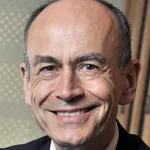
Stanford Report, October 14, 2013
Last week Stanford University cheered the announcement of two new Nobel laureates on campus.
On Oct. 7, Thomas Südhof, a professor of molecular and cellular physiology, won the 2013 Nobel Prize in Physiology or Medicine. Two days later, Michael Levitt, a professor of structural biology at the Stanford School of Medicine, won the 2013 Nobel Prize in Chemistry.
Although his work has focused on the minutiae of how molecules interact on the cell membranes, the fundamental questions he's pursuing are large.
Südhof was recognized for his role in discovering the machinery that regulates vesicle traffic, a major transport system within our cells. In particular, Südhof, the Avram Goldstein Professor in the School of Medicine, received the award for his fundamental research in exploring how neurons in the brain communicate with one another across gaps called synapses.
"We'd like to understand how synapse communication leads to learning on a larger scale," he said the morning the award was announced. "How are the specific connections established? How do they form? And what happens in schizophrenia and autism when these connections are compromised?"
The prize in physiology or medicine was a Stanford family affair: Südhof shared the honor with James Rothman, PhD, a former Stanford professor of biochemistry, and Randy Schekman, PhD, who earned his doctorate at Stanford. Rothman is now a professor at Yale University, and Schekman is a professor at UC-Berkeley.
For complete coverage on Südhof's Nobel Prize, click here.
On Wednesday, Levitt, the Robert W. and Vivian K. Cahill Professor in Cancer Research, was honored for his work in pioneering computational structural biology, focusing on theoretical, computer-aided analysis of protein, DNA and RNA molecules responsible for life at its most fundamental level.
The approach has blossomed to help to predict molecular structures, compute structural changes, refine experimental structure, model enzyme catalysis and classify protein structures.
His basic research set the stage for a rapidly growing field – delineating the precise molecular structures of biological molecules is a critical first step in understanding how they work and in designing drugs to alter their function. Among the practical applications of Levitt's are methods for antibody humanization that are key for modern anticancer therapy, such as the drug Avastin.
Levitt shared his $1.2 million prize with Martin Karplus of the University of Strasbourg in France and Harvard University, and Arieh Warshel of the University of Southern California.
Although both Südhof and Levitt have been mentioned as potential Nobel winners for some time, the once-in-a-lifetime moment caught both of them by surprise.
"I'm absolutely surprised," said Südhof, 57, who was in the remote town of Baeza, Spain, to attend a conference and give a lecture when he got the phone call. "Every scientist dreams of this. I didn't realize there was a chance I would be awarded the prize," he said.
Both scientists also expressed an eagerness to get back to work.
"I went to sleep last night very excited about the work that's been done in my lab this week," said Levitt. "Yesterday someone in my lab devised a new way to do a calculation thousands of times faster than before. When something becomes so fast, it opens up whole new possibilities. So, of course I'm excited about the Nobel. But I am passionate about my research. Passion is really important for anything you do; it's a general requirement."
For more coverage of Levitt's Nobel Prize, click here.


